Context Research
Context Research
In the background research I postulated the need for a focus shift from static architectural concepts to a more interactive architectural approach. Here, new technologies such as smart materials which react to different kinds of inputs (temperature, noise, humidity, light, pressure, movement etc.) can help. New strategies of decentralized, meshed networks to replace existing centralized networks help coordinate hundreds, if not thousands of sensors in buildings. This transforms buildings to act like an organism with a nervous system capable of smelling, feeling as well as reacting to circumstances in such a way that the building becomes aware. As this is still a fairly broad topic, a focus is needed. So I analysed different kinds of aspects of an interior of a building to find interesting
things happening. I realized at the end of my research that I had found a potentially interesting aspect of a building which is now currently under investigation as a mood board. In this
pdf, you can see the path leading to this focal point of interest.
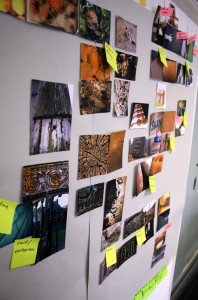
- urban decay / organic decay / aging / wear & tear
- erosion, corrosion
- fungi / mushrooms
- human skin /skin folds
- goose bumps
- haunted house and Feng Shui
- irritating noises
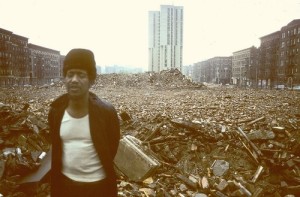 Urban and architectural decay often appeals to the imagination. While some consider the unfinished parts of the city as ugly or disturbing, others feel they make an area more interesting than the picture perfect urban fabric. The city’s scars are stimuli for the mind. They raise questions, about memories and imaginations of a foregone past, and of potential futures. They visualize the passage of time and the inevitability of collapse. On a smaller level, they show traces of faded lives, moved communities and shrunken economies. The voids provide space for the observer to interpret them as he likes, to fill them with imaginations and meanings. Decay provokes thoughts and actions and is the creative inspiration for many artists and writers.
Urban and architectural decay often appeals to the imagination. While some consider the unfinished parts of the city as ugly or disturbing, others feel they make an area more interesting than the picture perfect urban fabric. The city’s scars are stimuli for the mind. They raise questions, about memories and imaginations of a foregone past, and of potential futures. They visualize the passage of time and the inevitability of collapse. On a smaller level, they show traces of faded lives, moved communities and shrunken economies. The voids provide space for the observer to interpret them as he likes, to fill them with imaginations and meanings. Decay provokes thoughts and actions and is the creative inspiration for many artists and writers.



Organic decay can be a fast (fruit) or slow (wood) process and is usually an ugly but needful business. Aging is a process associated before the decaying happens. This can have positive (violin) or negative (human mobility) consequences. Wear and tear can be painful for humans and is due to repetitive movements over years. Cobblestone wear is a longer process by walking over them over centuries. This can also happen through erosion or corrosion.
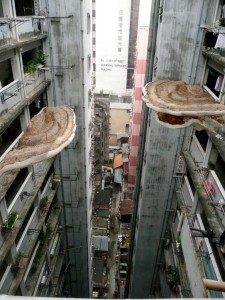
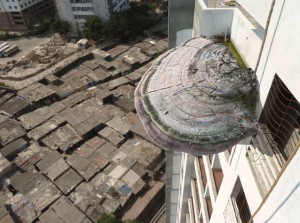
Mushrooms/fungi live on decay, neutralize poisonous substances for example. This has led to ideas of cultivating massive mushrooms in cities to clean the air or harvesting electricity from them.
This led me to investigate more into irritating noise, which usually causes the “spookiness”:
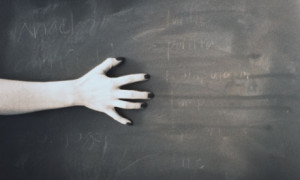 Scraping a chalkboard with the fingernails produces a sound which most people find extremely irritating. The basis of this reaction has been studied in the field of psychoacoustics.
Scraping a chalkboard with the fingernails produces a sound which most people find extremely irritating. The basis of this reaction has been studied in the field of psychoacoustics.
One explanation for the adverse reaction is that the sound is similar to the warning call of a primate. However, a study using Cottontop Tamarins, a New World Monkey, found that they react similarly to both high-pitched sounds similar to fingernails on chalkboard, and to amplitude-matched white noise. In contrast, humans are less averse to the white noise than to scrap ing.
A 1986 study used a tape-recording of a three-pronged garden tool similar to a fork being “grided” across a chalkboard, which roughly reproduces the sound of fingernails on chalkboard. The authors hypothesized that it was due to predation early in human evolution; the sound bore some resemblances to the alarm call of macaque monkeys, or it may have been similar to the call of some predator.
Infrasound or low-frequency sound (>20Hz) can produce a psychoacoustic phenomena which can be perceived as fearful, unnerving, spooky. Wikipedia describes it as follows:
One study has suggested that infrasound may cause feelings of awe or fear in humans. It also was suggested that since it is not consciously perceived, it may make people feel vaguely that odd or supernatural events are taking place.
The frequency of 18Hz is according to the NASA the resonance frequency of the eye and can lead to ghost sightings.
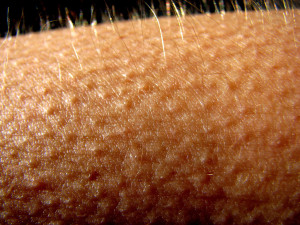

 Urban and architectural decay often appeals to the imagination. While some consider the unfinished parts of the city as ugly or disturbing, others feel they make an area more interesting than the picture perfect urban fabric. The city’s scars are stimuli for the mind. They raise questions, about memories and imaginations of a foregone past, and of potential futures. They visualize the passage of time and the inevitability of collapse. On a smaller level, they show traces of faded lives, moved communities and shrunken economies. The voids provide space for the observer to interpret them as he likes, to fill them with imaginations and meanings. Decay provokes thoughts and actions and is the creative inspiration for many artists and writers.
Urban and architectural decay often appeals to the imagination. While some consider the unfinished parts of the city as ugly or disturbing, others feel they make an area more interesting than the picture perfect urban fabric. The city’s scars are stimuli for the mind. They raise questions, about memories and imaginations of a foregone past, and of potential futures. They visualize the passage of time and the inevitability of collapse. On a smaller level, they show traces of faded lives, moved communities and shrunken economies. The voids provide space for the observer to interpret them as he likes, to fill them with imaginations and meanings. Decay provokes thoughts and actions and is the creative inspiration for many artists and writers.


 Organic decay can be a fast (fruit) or slow (wood) process and is usually an ugly but needful business. Aging is a process associated before the decaying happens. This can have positive (violin) or negative (human mobility) consequences. Wear and tear can be painful for humans and is due to repetitive movements over years. Cobblestone wear is a longer process by walking over them over centuries. This can also happen through erosion or corrosion.
Organic decay can be a fast (fruit) or slow (wood) process and is usually an ugly but needful business. Aging is a process associated before the decaying happens. This can have positive (violin) or negative (human mobility) consequences. Wear and tear can be painful for humans and is due to repetitive movements over years. Cobblestone wear is a longer process by walking over them over centuries. This can also happen through erosion or corrosion.

 Mushrooms/fungi live on decay, neutralize poisonous substances for example. This has led to ideas of cultivating massive mushrooms in cities to clean the air or harvesting electricity from them.
This led me to investigate more into irritating noise, which usually causes the “spookiness”:
Mushrooms/fungi live on decay, neutralize poisonous substances for example. This has led to ideas of cultivating massive mushrooms in cities to clean the air or harvesting electricity from them.
This led me to investigate more into irritating noise, which usually causes the “spookiness”:
 Scraping a chalkboard with the fingernails produces a sound which most people find extremely irritating. The basis of this reaction has been studied in the field of psychoacoustics.
One explanation for the adverse reaction is that the sound is similar to the warning call of a primate. However, a study using Cottontop Tamarins, a New World Monkey, found that they react similarly to both high-pitched sounds similar to fingernails on chalkboard, and to amplitude-matched white noise. In contrast, humans are less averse to the white noise than to scrap ing.
A 1986 study used a tape-recording of a three-pronged garden tool similar to a fork being “grided” across a chalkboard, which roughly reproduces the sound of fingernails on chalkboard. The authors hypothesized that it was due to predation early in human evolution; the sound bore some resemblances to the alarm call of macaque monkeys, or it may have been similar to the call of some predator.
Infrasound or low-frequency sound (>20Hz) can produce a psychoacoustic phenomena which can be perceived as fearful, unnerving, spooky. Wikipedia describes it as follows:
One study has suggested that infrasound may cause feelings of awe or fear in humans. It also was suggested that since it is not consciously perceived, it may make people feel vaguely that odd or supernatural events are taking place.
The frequency of 18Hz is according to the NASA the resonance frequency of the eye and can lead to ghost sightings.
Scraping a chalkboard with the fingernails produces a sound which most people find extremely irritating. The basis of this reaction has been studied in the field of psychoacoustics.
One explanation for the adverse reaction is that the sound is similar to the warning call of a primate. However, a study using Cottontop Tamarins, a New World Monkey, found that they react similarly to both high-pitched sounds similar to fingernails on chalkboard, and to amplitude-matched white noise. In contrast, humans are less averse to the white noise than to scrap ing.
A 1986 study used a tape-recording of a three-pronged garden tool similar to a fork being “grided” across a chalkboard, which roughly reproduces the sound of fingernails on chalkboard. The authors hypothesized that it was due to predation early in human evolution; the sound bore some resemblances to the alarm call of macaque monkeys, or it may have been similar to the call of some predator.
Infrasound or low-frequency sound (>20Hz) can produce a psychoacoustic phenomena which can be perceived as fearful, unnerving, spooky. Wikipedia describes it as follows:
One study has suggested that infrasound may cause feelings of awe or fear in humans. It also was suggested that since it is not consciously perceived, it may make people feel vaguely that odd or supernatural events are taking place.
The frequency of 18Hz is according to the NASA the resonance frequency of the eye and can lead to ghost sightings.
